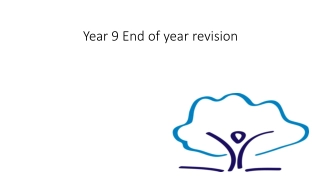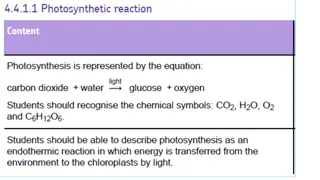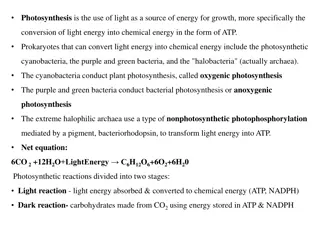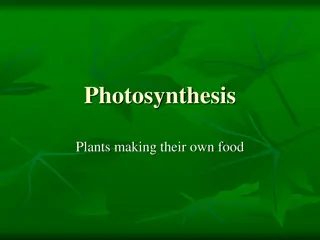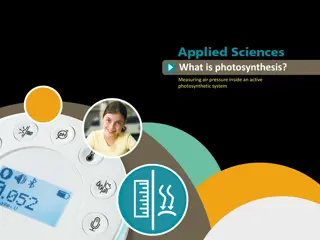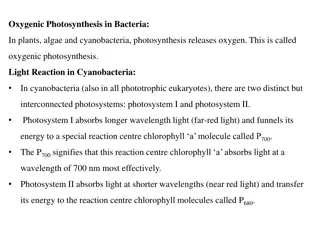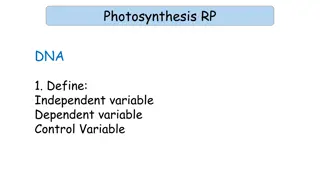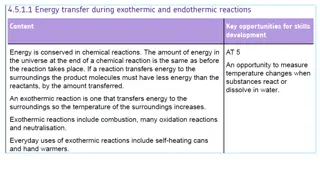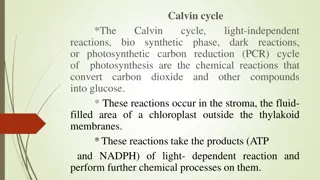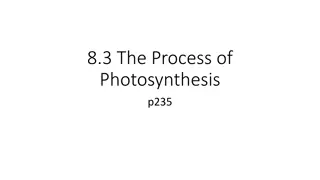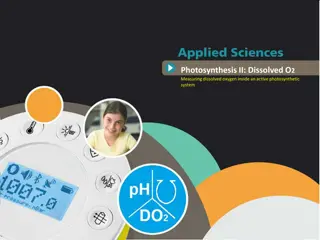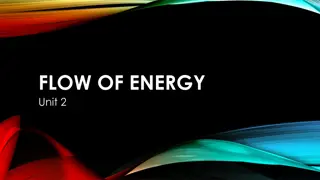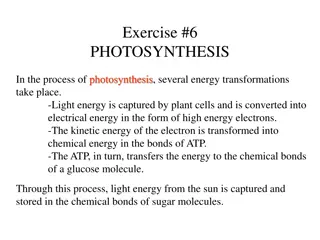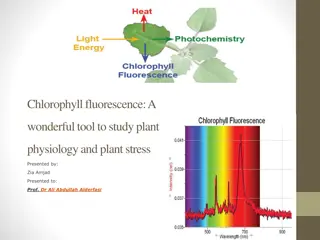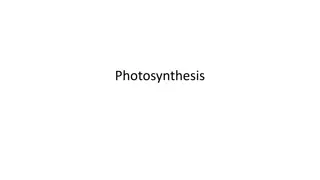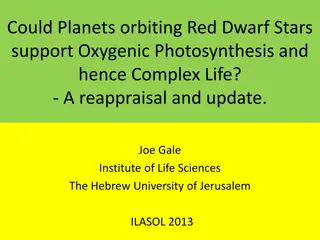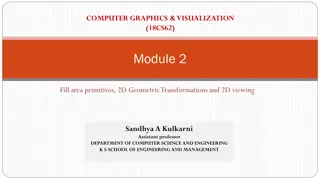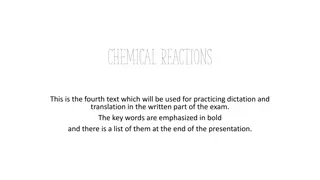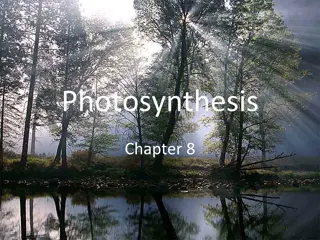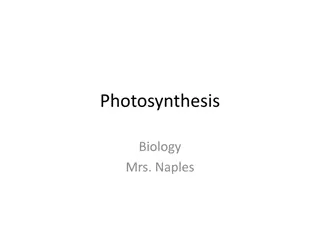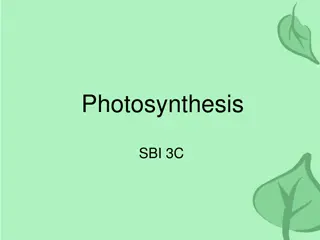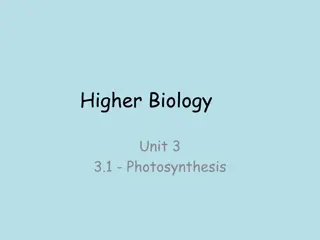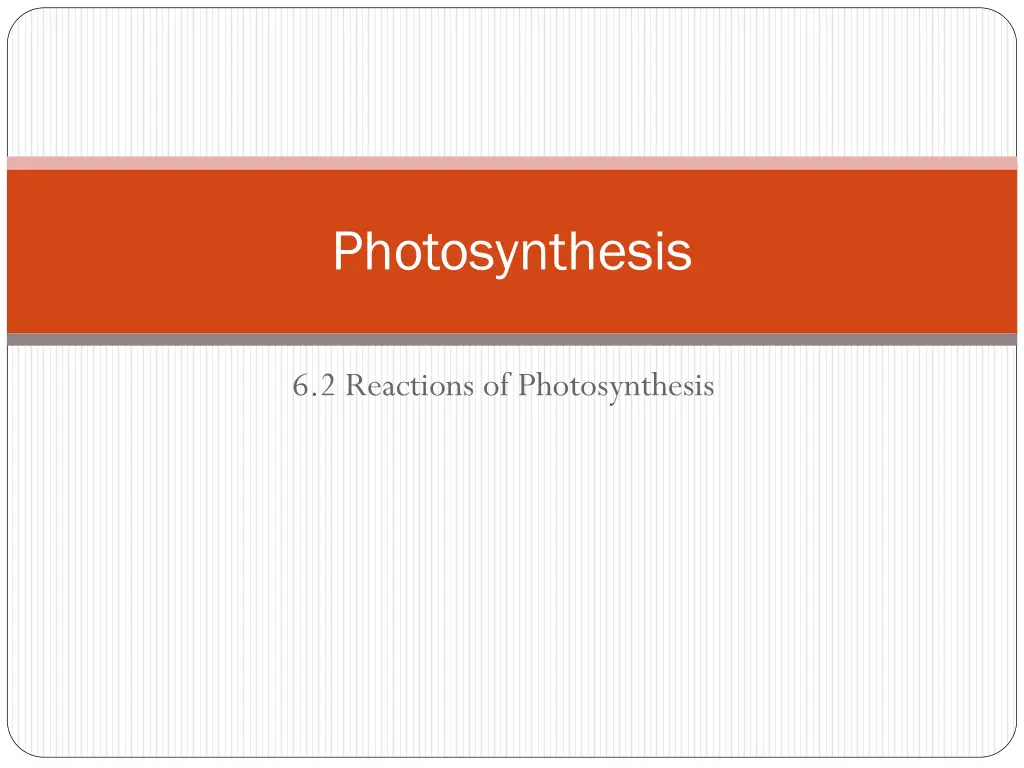
Photosynthesis Reactions and Energy Transfer
Learn about the intricate process of photosynthesis, including the stages, reactions, and energy transfer mechanisms involved. Discover how solar energy is converted into usable chemical energy to create glucose, the importance of molecules like ATP and NADPH, and the role of different stages in capturing and utilizing solar energy effectively.
Download Presentation

Please find below an Image/Link to download the presentation.
The content on the website is provided AS IS for your information and personal use only. It may not be sold, licensed, or shared on other websites without obtaining consent from the author. If you encounter any issues during the download, it is possible that the publisher has removed the file from their server.
You are allowed to download the files provided on this website for personal or commercial use, subject to the condition that they are used lawfully. All files are the property of their respective owners.
The content on the website is provided AS IS for your information and personal use only. It may not be sold, licensed, or shared on other websites without obtaining consent from the author.
E N D
Presentation Transcript
Photosynthesis 6.2 Reactions of Photosynthesis
Photosynthesis Purpose: to use _____________________ from sunlight to create glucose - solar energy converted to usable chemical energy Occurs in the ______________________ membranes within _______________________ Requires 6 molecules of __________ and 6 molecules of __________ During photosynthesis, many complex chemical reactions form intermediates and final ______________________ molecules - ______________: principal energy-supply molecule for living cells (immediate) - _________________: electron donor in energy transfers - ___________________: energy storage for later use by cells
ATP and NADPH Used by ___________ living things as an _____________________ source of energy for cellular functions Formed by addition of ___________________ group (Pi) to a molecule of lower energy _______. _________________ accepts one ______________________ atom and _______ electrons to form _____________________. - these electrons can then be ________________ to other molecules and NADPH becomes ____________________ again.
Reactions Stage 1: ____________________ solar energy and transferring it to ________________________ Stage 2: using captured solar energy to make ______________ and to transfer high-energy electrons to __________________; creates _____________________ (electron carrier) Stage 3: energy stored in ATP and electrons carried by NADPH used to form __________________ from _______________ Stage 1 & 2: light ______________________ reactions requiring ________________________ Stage 3: light ___________________________ _________________ __________________ forming glucose (due to carbon fixation)
Capturing Solar Energy (Stage 1) _________________________: clusters of ______________________ and pigment molecules - found on thylakoid _______________________ - 2 distinct but interconnected photosystems (I & II) Electrons in chlorophyll capture and absorb ______________________ - electron now has ______________ amount of energy (excited state) High-energy electrons move along electron _______________________ chain - NEED TO BE _________________________! ___________________________: solar energy used to split ______________ into H+and O2gas - occurs in thylakoid ___________________ - 2 H2O molecules consumed for every 4 electrons transferred
Electron Transfer & ATP Synthesis Electron Transfer & ATP Synthesis (Stage 2) (Stage 2) Electron Transport Chain: _____________ electrons are passed along the chain, slowly __________________ energy in each step - some of this energy is captured to make ___________ - electrons eventually rejoin H+to form new compounds
Electron Transfer & ATP Synthesis (Stage 2) Electron Transfer & ATP Synthesis (Stage 2) Photolysis: splits __________________, electrons move into Photosystem _________ Electrons then passed along ETC toward the inside of the thylakoid ______________________. - releases ___________________ - draws _______ ions across membrane toward __________ - concentration of H+ ions in lumen increases creating buildup of _______________________ charge Electrons enter Photosystem ______ - replace electrons energized by __________________ Energized electrons move through chemical complexes to ______________________ - accepts 2 high- energy __________________________ and an ________ ion; becomes __________________ - NADPH used in light-independent reaction (Calvin Cycle)
Chemiosmosis H+ ions pulled across membrane into ____________________ - creates concentration __________________; H+ cannot escape unless through ___________ synthase complexes - movement through releases _______________ Combines __________ with _______ .... creates.... _____________! Recall: energy stored in H+ ion gradient derived from energy of ____________________ energized in Photosystem ______
Review Stage 2 Light-dependent reactions:
Calvin Cycle & Carbon Fixation (Stage 3) Calvin Cycle & Carbon Fixation (Stage 3) Final stage of photosynthesis - results in formation of ____________________ organic molecules from _______ (carbon fixation) __________________ Cycle: - occurs in the _____________________ of chloroplasts - ____________ must be readily available -utilizes both __________ and high-energy electrons on ______________ from light-dependent reactions - makes ____________ (or _________________), a sugar used to create ___________________
Calvin Cycle & Carbon Fixation (Stage 3) Calvin Cycle & Carbon Fixation (Stage 3) Steps of Calvin Cycle: must cycle ________ times for ______ glucose to be produced Atmospheric __________ diffuses into chloroplast - carbon joins 5-carbon sugar _______________ (ribulose biphosphate) - forms ______________________ 6-carbon sugar Splits into _____________ 3-carbon sugars ___________ (phosphoglyceric acid) PGA s use energy of _________ to strip H from __________________ - makes a stable 3-carbon organic compound (__________ or _____________) and ____________________ PGAL (G3P): some goes on to make _________________, rest converted to __________________ to continue cycle
PGAL (G3P) The PGAL (phosphoglyceraldehyde) that goes on to make _______________________ must be united with another molecule of ___________________ in order for glucose to be formed. PGAL therefore has 3 important functions: - used for _________________________ to fuel the light independent reaction - some can be converted to ___________________ for energy _______________________ - a portion is used to replenish _________________ and drive the cycle

